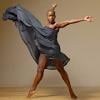
Dance of Dreams, a wee gem of a dance film directed by Benjamin Millepied, premiering Aug. 13, embodies in its six minutes everything San Francisco that we love and nothing (e.g. pandemics) we hate. For openers, it’s a product of the San Francisco Ballet and the artistry of its company, but includes eloquent contributions from four major choreographers (all of whom, like Millepied, donated their time), invited by San Francisco Ballet artistic director Helgi Tomasson. For another, it’s set to music from Alfred Hitchcock’s 1958 San Francisco thriller Vertigo, and filmed in some of the classiest and most-classic of San Francisco settings.
All these years later, it’s Vertigo composer Bernard Herrmann’s genius that sweeps the ballet along with the excerpt titled “Scene D’Amour.” It was played remotely by more than 60 members of the San Francisco Ballet Orchestra and superbly knitted together from more than 150 tracks. And what an affair of the heart it is. You won’t see many of the oft-ogled tourist spots here, but anyone who’s ever spent a couple of days or a lifetime in The City, as the columnist Herb Caen most correctly dubbed it, will inhale its inimitable atmosphere — the fog, the chill, the redemptive seconds of sunshine, the breeze from the bay.
There are six dancers. The solos for principal dancers Joseph Walsh and Frances Chung were choreographed by Justin Peck and Janie Taylor, respectively. There are also two pas de deux: one for soloists Ellen Rose Hummel and Daniel Deivison-Olveira, choreographed by Dwight Rhoden; the other, for soloist Madison Keesler and principal dancer Benjamin Freemantle, choreographed by Christopher Wheeldon. Director and choreographers all worked remotely.
Life being what it is, we must pause to mention that since this was shot five months into the Covid era, the entire film company observed all the rigors of social distancing, and the two pas de deux were danced by artists who have been sheltering in place together.

The locations were the roof of the San Francisco Art Institute, a spot near the Golden Gate Bridge, an overlook on the San Francisco Bay, and the courtyard of the Palace of Fine Arts. The weather seemed ideally suited to the proceedings — gray, breezy, and cool, with the promise of brighter, warmer moments, not unlike life in these times. Choreographically, each dancemaker and dancer seemed to capture and echo the yearning for a return to company life, blended with the intimacy of personal connections, the pain of loss. Stunning, poignant, and hopeful, Dance of Dreams is a marvelous record of this troupe, this art form, and this moment.




